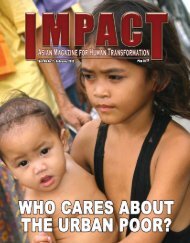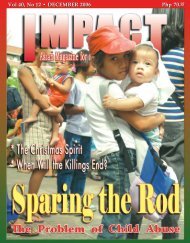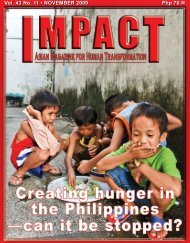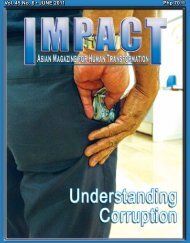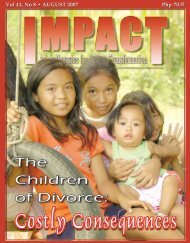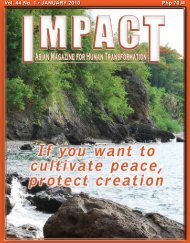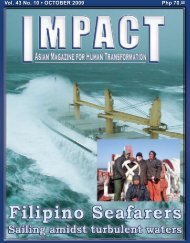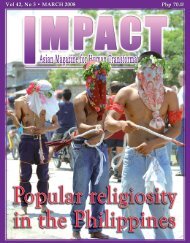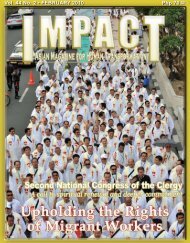Php 70.00 Vol. 45 No. 5 • MAY 2011 - IMPACT Magazine Online!
Php 70.00 Vol. 45 No. 5 • MAY 2011 - IMPACT Magazine Online!
Php 70.00 Vol. 45 No. 5 • MAY 2011 - IMPACT Magazine Online!
Create successful ePaper yourself
Turn your PDF publications into a flip-book with our unique Google optimized e-Paper software.
COVER<br />
STORY<br />
COVER<br />
STORY<br />
Who feels better now<br />
after a year of Aquino<br />
economy?<br />
The path to successful implementation of programs is riddled with<br />
potholes of bureaucratic corruption opportunities. And CCTs are not<br />
development programs; they cannot substitute for comprehensive<br />
development and poverty reduction strategies.<br />
By Charles Avila<br />
Do you feel better now<br />
than almost a year ago<br />
when a new President<br />
took the reins of power in seeming<br />
simplicity and egalitarian resoluteness?<br />
Didn’t you welcome<br />
him as a President of hope and<br />
the straight path, a President of<br />
militancy against corruption with<br />
the corrective bias for the poor?<br />
Well, he can’t believe that some<br />
of you actually think you are<br />
worse off now than before, and<br />
that you now feel hungrier and<br />
poorer than when he first started<br />
his watch; did you really think so?<br />
Is that what you told the social<br />
weather monitors and economic<br />
pulse-takers? His near free-fall<br />
in popularity is unbelievable, he<br />
understandably thinks, and all of<br />
that, he suspects, must be due to<br />
active foes.<br />
High Growth Rates?<br />
Didn’t the Philippine GDP<br />
grow 7.3% in 2010 spurred by<br />
election-related spending and a<br />
rebound in exports and investments?<br />
Due to large money infusions<br />
from millions of overseas<br />
Filipino workers, and a growing<br />
business process outsourcing industry<br />
(the call centers), and also<br />
on account of minimal exposure<br />
to troubled international securities,<br />
as well as lower dependence<br />
on exports, the Philippines did<br />
weather the 2008-09 global recession<br />
better than her regional<br />
peers.<br />
Economic growth averaged<br />
4.5% during the previous administration.<br />
Despite this growth,<br />
however, poverty worsened. In<br />
fact, Philippine poverty has been<br />
continuously worsening in recent<br />
years. The 2009 official estimates<br />
of the National Statistical Coordination<br />
Board (NSCB) put the<br />
poverty headcount ratio at 26.5<br />
percent, higher than that of 2006<br />
(26.4%), and 2003 (24.9%). Will<br />
the trend be different in the P<strong>No</strong>y<br />
economy?<br />
This rise in the poverty rate,<br />
particularly between 2003 and<br />
2006, was due both to lack of real<br />
growth and to worsening income<br />
distribution. Everybody knows<br />
that what matters in poverty<br />
reduction is not just economic<br />
growth but the nature of expansion<br />
that takes place. <strong>No</strong>t just<br />
growth but an effective redistributive<br />
effort is necessary. For in-<br />
stance, as we will further discuss<br />
later: increasing rural incomes<br />
by improving nonfarm income<br />
opportunities is key to reducing<br />
poverty in the rural areas, which<br />
is where the highest incidence of<br />
poverty is―ironically under three<br />
hundred twenty-five million coconut<br />
trees bearing fifteen billion<br />
coconut fruits yearly, producing<br />
so much wealth for a few companies<br />
and so much poverty for<br />
small holders nationwide.<br />
To weather the effects of<br />
economic shocks, families need<br />
safety nets like health and crop<br />
insurance that will help the poor<br />
among them from falling deeper<br />
into the poverty trap and the<br />
non-poor into becoming multidimensionally<br />
poor in times of<br />
crises. In the coconut industry<br />
that has more than 20 million<br />
Filipinos dependent on it for<br />
their livelihood, a typical small<br />
coconut farmer must be guided<br />
from a single income lane along<br />
the production of copra into many<br />
other income streams to double,<br />
triple or even quintuple his net<br />
income.<br />
These income streams include<br />
the production of fiber and<br />
cream and coconut water and so<br />
many other things now in great<br />
demand due to the natural superiority<br />
of the coconut itself, which<br />
we so easily grow in our lands<br />
but which cannot be produced<br />
in other countries that have such<br />
great demand for them—as, for<br />
example, for coconut sugar from<br />
sap that diabetics would rather<br />
have than synthetic substitutes,<br />
for monolaurin and mediumchain<br />
triglycerides that all the<br />
hospitals of the world clamor<br />
for, for roofing mats and organic<br />
fertilizer from leaves, for antierosion<br />
mats from fiber, for flour,<br />
virgin coconut oil, and milk from<br />
fresh coconut, aside from the traditional<br />
huge demand for refined<br />
edible oil, soaps and detergents,<br />
animal feed and bio-diesel.<br />
Indeed, the coco-agro-industrialization<br />
of the majority<br />
provinces of our country is a<br />
hoarse cry whose urgency cannot<br />
be ignored except by those<br />
who don’t understand the natural<br />
competitive advantage gifted by<br />
Providence to this archipelago.<br />
Do the P<strong>No</strong>y economists know<br />
this?<br />
Could not a P<strong>No</strong>y economy<br />
allow at last the immediate utilization<br />
of billions of pesos of<br />
coco-levy-based San Miguel Corporation<br />
annual dividends for just<br />
such a purpose and for the implementation,<br />
finally, of modern<br />
coco-based farming systems that<br />
will utilize 80% more of about 4<br />
million hectares of coconut lands<br />
and make them bloom with intercrops<br />
from cereals, legumes, root<br />
crops, fruit crops and vegetables,<br />
even to tree crops and livestock<br />
production? All these, after all,<br />
were the original purposes of the<br />
levy before they got hijacked by<br />
a few guys for their own narrow<br />
interests.<br />
The Precise Nature of Philippine<br />
Poverty<br />
The P<strong>No</strong>y economists may<br />
not realize it but Philippine poverty<br />
is mainly rural poverty and<br />
rural poverty is in great part<br />
the poverty of the small coconut<br />
farmer. If they could only<br />
scientifically, strategically and<br />
systematically target this specific<br />
sector of the national economy,<br />
they could then eliminate the<br />
problem of Philippine poverty<br />
by some 70%.<br />
It is easy to have a false<br />
sense of security when one sees<br />
how even during the slow season,<br />
as in the first two months<br />
of this year, money sent home<br />
by Filipinos living and working<br />
overseas, grew 6.9% from a year<br />
ago to $3 billion, notwithstanding<br />
the ongoing crises in the Middle<br />
East, <strong>No</strong>rth Africa and Japan.<br />
Remember that aside from Japan,<br />
Saudi Arabia and the United Arab<br />
Emirates, other main sources of<br />
remittances are the US, Canada,<br />
Singapore and Italy. The demand<br />
for Filipinos abroad as<br />
well as the existence of easy and<br />
cheap money transfer schemes<br />
continues to boost remittance<br />
inflows—given beforehand the<br />
fact of rural poverty that pushes<br />
our people out of our shores into<br />
becoming the ‘remittance heroes’<br />
they are abroad. For, indeed, it<br />
takes heroic guts to brave the<br />
dangers of wars and natural disasters<br />
just to make a few more<br />
bucks to send to loved ones at<br />
home. This year, remittances are<br />
expected to grow by 8% from<br />
the record $18.8 billion in 2010.<br />
Remittances affect the country's<br />
© Roy Lagarde / CBCP Media<br />
16 <strong>IMPACT</strong> <strong>•</strong> May <strong>2011</strong><br />
<strong>Vol</strong>ume <strong>45</strong> <strong>•</strong> Number 5 17



